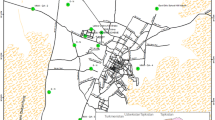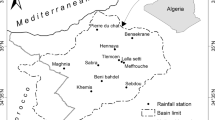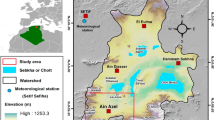Abstract
Quantity and quality distribution of surface water and groundwater are changing under the impacts of both climate variability and human activities. The main goal of this paper is to evaluate the abovementioned impacts on the water resources in the Saveh plain, central Iran. To achieve this aim, spatial and temporal changes of the surface and groundwater quality and quantity have been analyzed, using hydrometric and meteorological data. The nonparametric Mann-Kendall test was used to identify trends and change points in the annual rainfall and runoff for the period of 1946 to 2011. In order to analyze the impacts of the Saveh Dam on runoff, the dam operation year, 1994, was considered as a change point. Mann-Kendall test results show that rainfall time series was divided into two parts, namely, 1966–1989 and 1990–2007, and averages of annual rainfall in five stations increase from 10 to 21 %. Also, runoff time series was divided into two parts, namely, 1946–1995 and 1996–2007 and averages of annual runoff in four stations decrease from 8 to 83 %. Results show that rainfall changes in Shahabasi, Razin, Jalayer, Emamabad, and Ahmadabad stations increased from 9 to 33 % before and after 1994. Nevertheless, runoff decreased from 24 to 81 %. The results indicate that the greatest lack of runoff between stations is at Shahabasi station and one important reason for the severe lack is operation of the Saveh Dam in 1994. Highest groundwater level decline, about 168.67 cm, occurred in 1994 that is the operation year of the Saveh Dam. Trend analysis of surface water quality show that electrical conductivity increased 957.34 μmho/cm before and after 1994. Also, the Wilcox water quality classification method has been reduced from C3-S1 to C4-S2. Average groundwater electrical conductivity (EC) during 1999–2003 and 2004–2009 increased to 89.6 μmho/cm. Also, the groundwater quality indices for agricultural usages are classified in four classes including, C4-S2 16, C4-S1 46, C3-S1 30, and C2-S1 8 % of the total aquifer area. In conclusion, in order to have a sustainable development, the effects of water projects on environment and water resources need to be predicted very carefully.







Similar content being viewed by others

References
Adger, N., & Coauthors. (2007). Summary for policy makers. Climate change 2007: impacts, adaptation and vulnerability. In M. L. Parry et al. (Eds.), Cambridge University Press, 7–22.
Ahmadi, S. H., & Sedghamiz, A. (2007). Geostatistical analysis of spatial and temporal variations of groundwater level. Environmental Monitoring and Assessment, 129, 277–294.
Almasri, M. N., & Kaluarachchi, J. J. (2004). Assessment and management of long-term nitrate pollution of groundwater in agriculture-dominated watersheds. Journal of Hydrology, 295, 225–245.
Bao, Z., Zhang, J., Wang, G., Fu, G., He, R., Jin, J., Liu, Y., Zhang, A., & Yan, X. (2012). Attribution for decreasing streamflow of the Haihe River basin, northern China: climate variability or human activities. Journal of Hydrology, 460–461, 117–129.
Barnett, J., Webber, M., Wang, M., Finlayson, B., & Dickinson, D. (2006). Ten key questions about the management of water in the yellow river basin. Environmental Management, 38, 179–188.
Bovolo, C. I., Parkin, G., & Sophocleous, M. (2009). Groundwater resources, climate and vulnerability. Environmental Research Letters, 4(3), 1–4.
Broers, H. P., & Grift, B. (2004). Regional monitoring of temporal changes in groundwater quality. Journal of Hydrology, 296, 192–220.
Brouyère, S., Carabin, G., & Dassargues, A. (2004). Climate change impacts on groundwater resources: modelled deficits in a chalky aquifer, Geer basin. Belgium Hydrogeology Journal, 12, 123–134.
Chen, Z., Grasby, S. E., & Osadetz, K. G. (2002). Predicting average annual groundwater levels from climatic variables: an empirical model. Journal of Hydrology, 260, 102–117.
Chen, Z., Grasby, S. E., & Osadetz, K. G. (2004). Relation between climate variability and groundwater levels in the upper carbonate aquifer, southern Manitoba, Canada. Journal of Hydrology, 290, 43–62.
Chen, Z., Chen, Y., & Li, B. (2013). Quantifying the effects of climate variability and human activities on runoff for Kaidu River Basin in arid region of northwest China. Theoretical and Applied Climatology, 111, 537–545.
Custodio, E. (2002). Aquifer overexploitation: what does it mean? Hydrogeology Journal, 10, 254–277.
Dams, J., Woldeamlak, S. T., & Batelaan, O. (2008). Predicting land-use change and its impact on the groundwater system of the KleineNete catchment, Belgium. Hydrology and Earth System Sciences, 12, 1369–1385.
Dragoni, W., Sukhija, B.S. (2008). Climate Change and groundwater: a short review. Geological Society Special Publication, 1–12.
Eltahir, E. A. B., & Yeh, P. J. F. (1999). On the asymmetric response of aquifer water level to floods and droughts in Illinois. Water Resource Research Journal, 35, 1199–1217.
Estrela, T., Marcuello, C., Iglesias, A., (1996). Water resources problems in Southern Europe. European Environmental Agency.
Green, T. R., Bates, B. C., Charles, S. P., & Fleming, P. M. (2007a). Physically based simulation of potential effects of carbon dioxide—altered climates on groundwater recharge. Vadose Zone Journal, 3, 597–609.
Green, T. R., Taniguchi, M., & Kooi, H. (2007b). Potential impacts of climate change and human activity on subsurface water resources. Vadose Zone Journal, 3, 531–532.
Guo, Y., Li, Z., Amo-Boateng, M., Deng, P., & Huang, P. (2014). Quantitative assessment of the impact of climate variability and human activities on runoff changes for the upper reaches of Weihe River. Stochastic Environmental Research and Risk Assessment, 28, 333–346.
Hennessy, K., Page, C., Durack, P., Bathols, J. (2006). Climate change projections for Victoria. CSIRO Marine and Atmospheric Research, Aspendale, Victoria 3195.
Holman, I. P. (2006). Climate change impacts on groundwater recharge-uncertainty, shortcomings, and the way forward. Hydrogeology Journal, 14, 637–647.
Hu, Z., Wang, L., Wang, Z., Hong, Y., & Zheng, H. (2014). Quantitative assessment of climate and human impacts on surface water resources in a typical semi-arid watershed in the middle reaches of the Yellow River from 1985 to 2006. International Journal of Climatology. doi:10.1002/joc.3965.
IPCC, et al. (2007). Climate change 2007: the physical science basis. In S. Solomon (Ed.), Contribution of working group I to the fourth assessment report of the intergovernmental panel on climate change (p. 996). Cambridge: Cambridge University Press.
Karl, & Trenberth, K. E. (2003). Modern global climate change. Science, 302, 1719–1723.
Kundzewicz, Z. W., Mata, L. J., Arnell, N. W., Doll, P., Kabat, P., Jimenez, B., Miller, K. A., Oki, T., Sen, Z., & Shiklomanov, I. A. (2007). Freshwater resources and their management. In M. L. Parry, O. F. Canziani, J. P. Palutikof, P. J. van der Linden, & C. E. Hanson (Eds.), Climate change 2007: impacts, adaptation and vulnerability (pp. 173–210). Cambridge: Cambridge University Press.
McCarthy, J. J., Canziani, O. F., Leary, N. A., Dokken, D. J., & White, K. S. (Eds.). (2001). Climate change 2001: impacts, adaptation, and vulnerability. Cambridge: Cambridge University Press.
McKee, T. B., Doesken, N. J., & Kleist, J. (1993). The relationship of drought frequency and duration to time scales, paper presented at 8th conference on applied climatology. Anaheim: American Meteorological Society.
McKee, T. B., Doesken, N. J., & Kleist, J. (1995). Drought monitoring with multiple time scales, paper presented at 9th conference on applied climatology. Dallas: American Meteorological Society.
Ministry of Energy of Iran, Iran Water Resource Management Company. (2005). Status evaluation of groundwater resources of Iran. Tehran, Iran (available in Persian).
Pearson, K. (1895). Mathematical contributions to the theory of evolution, II: skew variation in homogeneous material. Philosophical Transactions Royal Society Proceedings, 58, 241.
Scheidleder, A., Grath, J., Winkler, G., Stark, U., Koreimann, C., Gmeiner, C., Nixon, S., Casillas, J., Gravesen, P., Leonard, J., Elvira, M. (1999). Groundwater quality and quantity in Europe. European environment agency.
Scibek, J., & Allen, D. M. (2006). Comparing modelled responses of two highpermeability, unconfined aquifers to predicted climate change. Global and Planetary Change, 50, 50–62.
Shanshan, H. U., Changming, L., Hongxing, Z., Zhonggen, W., & Jingjie, Y. (2012). Assessing the impacts of climate variability and human activities on stream flow in the water source area of Baiyangdian Lake. Journal of Geographical Sciences, 22, 895–905.
Skinner, A. C. (2008). Groundwater: still out of sight but less out of mind. Quarterly Journal of Engineering Geology and Hydrogeology, 41, 5–19.
Sophocleous, M. A. (2004). Global and regional water availability and demand: prospects for the future. Natural Resources Research, 13, 61–75.
Taylor, C.J., Alley, W.M. (2001). Groundwater level monitoring and the importance of long-term water level data. U.S. Geological Survey, Circular 1217.
Van der Kamp, G., & Maathuis, H. (1991). Annual fluctuations of groundwater levels as a result of loading by surface moisture. Journal of Hydrology, 127, 137–152.
Wang, W., Shao, Q., Yang, T., Peng, S., Xing, W., Sun, F., & Luo, Y. (2013). Quantitative assessment of the impact of climate variability and human activities on runoff changes: a case study in four catchments of the Haihe River basin. China Hydrological Process, 27, 1158–1174.
Warner, S. D. (2007). Climate change, sustainability, and ground water remediation: the connection. Groundwater Monitoring and Remediation, 27, 50–52.
Wentz, L., Ricciardulli, K. H., & Mears, C. (2007). How much more rain will global warming bring? Science, 317, 233–235.
Wilcox, L. V. (1955). Classification and use of irrigation waters, United States salinity laboratory, circular no. 969 (p. 9). Washington, D. C.: USDA.
Woldeamlak, S. T., Batelaan, O., & De Smedt, F. (2007). Effects of climate change on the groundwater system in the Grote-Nete catchment. Belgium Hydrogeology Journal, 15, 891–901.
Wu, Y., & Chen, J. (2013). Investigating the effects of point source andnonpoint source pollution on the water quality of the East River (Dongjiang) in South China. Ecological Indicators, 32, 294–304.
Wu, Y., & Liu, S. (2012). Modeling of land use and reservoir effects on nonpoint source pollution in the Iowa River Basin. Journal of Environmental Monitoring, 14, 2350–2361.
Ye, X., Zhang, Q., Liu, J., Li, X., & Xu, C. (2013). Distinguishing the relative impacts of climate change and human activities on variation of stream flow in the Poyang Lake catchment. China Journal of Hydrology, 494, 83–95.
Zhang, A., Zhang, C., Fu, G., Wang, B., Bao, Z., & Zheng, H. (2012). Assessments of impacts of climate change and human activities on runoff with SWAT for the Huifa River Basin. Northeast China Water Resource Management, 26, 2199–2217.
Acknowledgments
This work has been supported by the University of Tehran. The authors are grateful to the university and also to the Iran Water Resources Management Company for providing required data.
Author information
Authors and Affiliations
Corresponding author
Rights and permissions
About this article
Cite this article
Mohammadi Ghaleni, M., Ebrahimi, K. Effects of human activities and climate variability on water resources in the Saveh plain, Iran. Environ Monit Assess 187, 35 (2015). https://doi.org/10.1007/s10661-014-4243-2
Received:
Accepted:
Published:
DOI: https://doi.org/10.1007/s10661-014-4243-2



